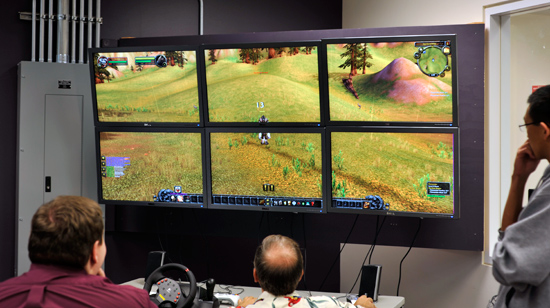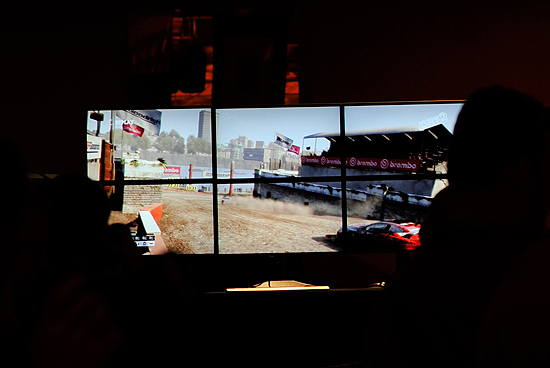Beginnings of the Holodeck: AMD's DX11 GPU, Eyefinity and 6 Display Outputs
by Anand Lal Shimpi on September 10, 2009 2:30 PM EST- Posted in
- GPUs
The First Generation Holodeck by 2016
When AMD first told me about the RV770 they told me another interesting story. For the past several years AMD (and ATI before it) has been obsessed with trying to figure out when it would be possible to render an image so convincing that it was indistinguishable (at least mostly) from reality.
Given the right art and a good technique to render the scene, this is totally possible not only within our lifetimes but within the next decade. Unfortunately, that's not enough.
Carrell estimates that the human eye can directly resolve around 7 million pixels, almost twice the resolution of a 30" display. But that's just what it's directly focusing on, all of the peripherial vision brings the total up to around 100 million pixels. The Eyefinity demo I showed earlier was running at 24.5 million pixels on a single GPU; you can estimate that at this generation we'll be able to do about 50 million pixels with two GPUs and one more generation from now we'll get to that 100 million pixel marker. That's two years for a single GPU. Then give it a few more years to be able to render that many pixels but with enough complexity to actually look real.
Rendering something at the max resolution that the human eye can resolve isn't enough however; you have to feel immersed in the graphics. That's where Eyefinity comes in, at least what it starts to come in.
Carrell believes that in seven years we can have the first generation Holodeck up and running. For those of you who aren't familiar with the Trek reference, Carrell believes it'll take seven years to be able to deliver a 180 degree hemispherical display (you're not completely surrounded by displays but at least your forward and peripheral vision is) with positionally accurate and phase accurate sound (both calculated by the GPU in real time). The GPU will also be used to recognize speech, track gestures and track eye movement/position.
It doesn't solve the issue of not being able to walk forward indefinitely, but again this is only the first generation Holodeck.
Eyefinity isn't anywhere close, but if you understand the direction: it's a start.

We're at six 2560 x 1600 displays today, is it too far fetched to imagine a totally immersive display setup that renders at life-like resolutions?
First person shooters pretty much dictate that you'll need an odd number of displays to avoid your crosshairs spanning multiple monitors. With three displays you can begin to get the immersion effect, but buy five and you'll be completely surrounded by your game. And as I mentioned before, it doesn't require any special application or OS support, the drivers take care of everything: it just appears as a single, large, surface.
It seems trivial but honestly we haven't had the ability to easily support the ridiculous display setups we always see in sci-fi movies. Eyefinity at least makes it look like we can build the PCs from the Matrix.
Will it succeed? Who knows. Does it sound gimmicky? Sure. Is it cool? Yeah, I'd say so.

If panel prices could drop significantly enough where putting together an Eyefinity display setup didn't cost more than the graphics card, I think it'd be a much easier sell. Obviously AMD's next-generation GPU is more than just Eyefinity, but you'll hear about the rest late this month.










137 Comments
View All Comments
Zoomer - Saturday, September 12, 2009 - link
Solution: 6 * 1080p PROJECTORS!gospastic - Thursday, September 10, 2009 - link
enhanced immersion is lost when have you have stupid horizontal and vertical bars running across the display area.Sazar - Thursday, September 10, 2009 - link
I thought Dell was the first to embrace Display Port as it was part of the group that brought it to fruition.VaultDweller - Tuesday, September 15, 2009 - link
You are correct, but the article says that Apple was the first to embrace mini-DisplayPort (emphasis on the mini).Totally - Thursday, September 10, 2009 - link
Dell wasn't the first to embrace Displayport, it's Dell's freaking baby. I'm guessing Samsung it's the first to adopt it on a same scale as Dell.FullCon Solutions - Wednesday, April 7, 2010 - link
FullCon Solutions, LLC partnered with Duke University & Iowa State to promote the benefits of using 6-Sided, Fully Immersive CAVE's in the AEC & Marine Industries. FullScale Analysis of 3D models are dramatically improving communication between all stakeholders. Ultimately, this technology allows are clients to design better, clarify expectations sooner and profit from improved decision making.Would this be of any interest to you?
FullCon Solutions, LLC
David Fuller | President
shin0bi272 - Tuesday, November 8, 2011 - link
http://www.engadget.com/2007/08/10/omni-directiona...